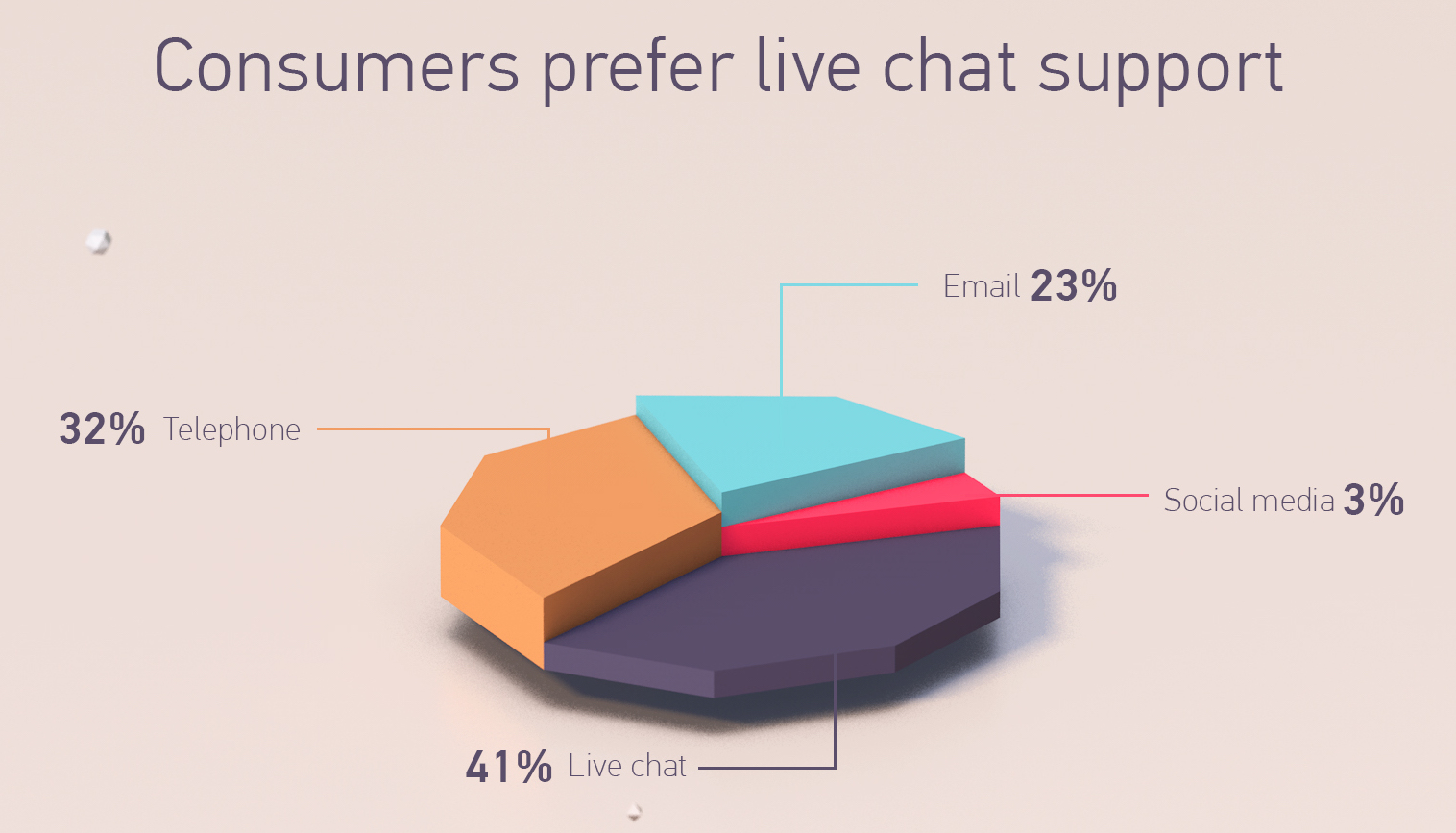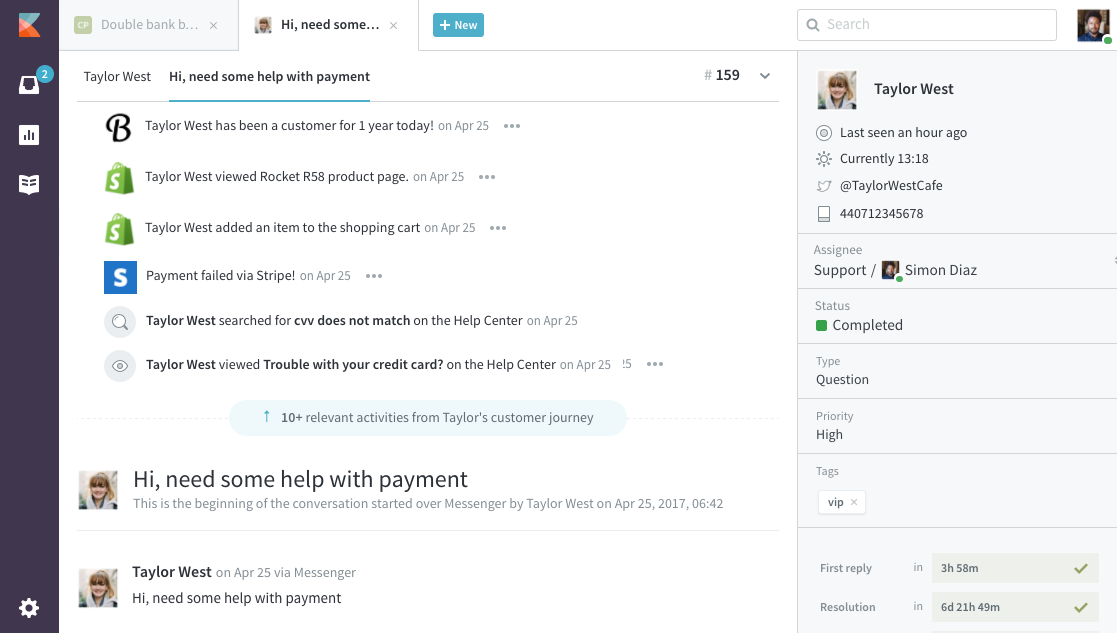Are you looking to add live chat to your customer support arsenal? If you are evaluating this, you can’t help but pull out a notepad, draw a line down the middle, and write “pros” and “cons” on either side. Except you won’t need to.
That’s exactly what we’ve done here for you today!
Rather than speculate on what makes a live chat software experience effortless or frustrating, Kayako surveyed 400 anonymous consumers and 100 anonymous businesses to find out what they think of live chat.
Let’s get to it.
What are the advantages and disadvantages of live chat software?
The pros:
- Good experiences spread through word of mouth: 29% of consumers have told friends or colleagues about a positive live chat experience
- Live chat can increase purchases: 38% of consumers are more likely to buy from a company if they offer live chat support
- Live chat can boost customer loyalty: 51% of consumers are more likely to stay with or buy again from a company if they offer live chat support
- And, they’re happy to spend more! 63% of people who spend between $250-500 a month online are the most likely to both buy from and be loyal to companies that offer live chat.
The cons:
- Live chat has poor user experience: 38% of consumers think the user experience is not good enough, and 43% of businesses agree.
- Scripted responses are frustrating: 29% of consumers say they find scripted responses most frustrating, and 38% of businesses agree.
- Waiting for an agent fuels frustration: 24% of consumers say long wait times are their biggest frustration. 19% of businesses say their customers are most frustrated by long wait times.
- You have a half chance of having a good live chat interaction: 47% of customers haven’t had a positive live chat experience in the past month
- Customers hate having to repeat themselves: 9% of consumers say their customers are most annoyed by having to repeat themselves, and 16% of businesses agree.
The customer experience isn’t working on live chat support
From our live chat statistics survey, it’s clear live chat drives revenue and loyalty. But why is a satisfactory live chat experience hard to find?
To get to the bottom of this, we need to ask two additional questions:
- Are businesses structuring their support model the right way?
- Why is customer satisfaction so inconsistent and infrequent on live chat?
1. Are businesses prioritizing the right channel? Phone support vs. live chat
We found that businesses may be overstaffing telephone support:
- Businesses believe their customers are 42% likely to pick up the phone for help, and 35% are likely to start a live chat conversation.
- But 41% of consumers say their prefer live chat, with only 32% opting to dial for help.
 If businesses can route more resources towards live chat, there is a chance to improve customer satisfaction and reduce costs.
If businesses can route more resources towards live chat, there is a chance to improve customer satisfaction and reduce costs.
But this reallocation of resources won’t fix the problem overnight. We need to be asking a bigger question:
2. Why is offering live chat on your website so difficult?
It’s clear customers don’t want the typical user experience of live chat tools.
And teams don’t want to give customers this user experience either.
One of the biggest disadvantages of typical live chat tools is the burden they place on the shoulders of support managers about whether to even offer live chat as a support solution.
Typical live chat software is not geared for scalability.
Given the limitations of typical live chat software – where support managers have to use live chat in tandem with other tools (not a complete customer support solution) – scaling live chat support as your business grows is tough.
Your support system can get clunky because automations don’t fire exactly how you want them to, and vital customer information starts to fall through the cracks so you lose the chance to offer personal support.
Businesses have to match consumer channel demands.
As a support manager you fear leaving customers hanging, waiting to connect to an agent. You can’t risk understaffing a live chat team. The need for a reply within 5 minutes is vital or a customer will get frustrated at your slow service, try another channel for help, and be happy to speak out about their dissatisfaction on social media.
Context is missing to make customer support effortless.
Live chat tools integrate poorly with customer support systems. They act as an isolated channel where underfunded and understaffed support teams struggle to operate a siloed tool alongside their help desk or customer service software.
Live chat tools need to integrate into support inboxes. If you want to provide a great customer experience over live chat, your messenger tools need to make support offerings better.
Keeping on top of new or updated conversations is not enough.
As support teams, how many times do we receive typical chat conversations that look like this:

Although we’re happy to help the customer, deep down we’re frustrated they couldn’t give us more context on what they’ve tried, where they’re at, or what they’re trying to purchase.
Through endless back-and-forth, you find out what the problem is: Taylor’s inputting the CVV on the back of the card incorrectly.
But with journeys and conversations in Kayako, you needn’t go through through all this on your chat tool.
You can see Taylor’s Help Center browsing history and exactly what she was up to before she makes contact. Stripe and Shopify integrations tell the you that Taylor’s payment failed due to an incorrect CVV code.
And your response becomes easy.

How can businesses get ahead with live chat support?
There are four takeaways from our research that are vital in your evaluation of your next live chat tool.
1. Choose a live chat solution that puts people first.
Both consumers and agents are frustrated with the limitations of traditional live chat software. Customers have a poor user experience, and teams can’t improve because they don’t have the right context to be personal. Chatting with customers should be effortless – like messaging a friend.
2. Invest in providing great chat experiences.
Customers hate scripted responses and repeating themselves – and business know their customers’ experience this problem. Personal and memorable experiences are important for satisfaction and loyalty. Current live chat solutions aren’t built for personal experiences. Support must be quality, personal, and timely.
3. Be memorable through your personal touch.
It’s about context. You need to use customer data to delight customers.
We all take steps to help ourselves before reaching out to support. It’s essential for support teams to understand the support journey the customer has been on to avoid a repetitive experience.
4. Exceptional chat experience produce significant ROI.
A live chat option brings in more revenue. Customers believe this, and they also report they’re happy to increase their loyalty and spend more with a business that offers it as a support option. Businesses need to find a way to adopt live chat to increase profitability, but must also balance the customer experience.
The benefits of live chat for businesses are clear
Support teams have the ability to increase retention, keep customers loyal, and increase revenue for their business. But it hinges on the quality of support that can be provided over live chat.
The pros and cons on live chat support is clear. Typical live chat software is archaic and built from an operational first perspective. They don’t prioritize good customer experiences.
But support teams can be in complete control of the experience they provide by choosing a live chat option that’s effortless for customers and teams.
Try Kayako Messenger, the effortless live chat software that offers a better way to provide live support and convert visitors into customers in real-time. Sign up for a 14 day free trial now.